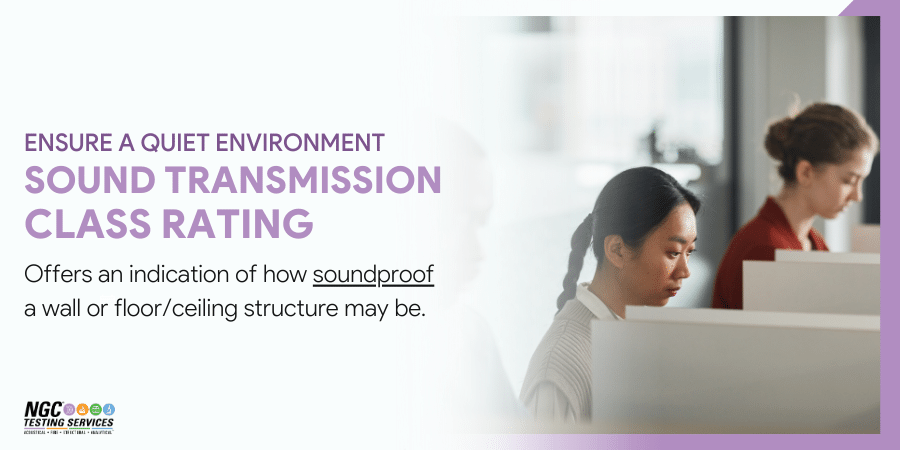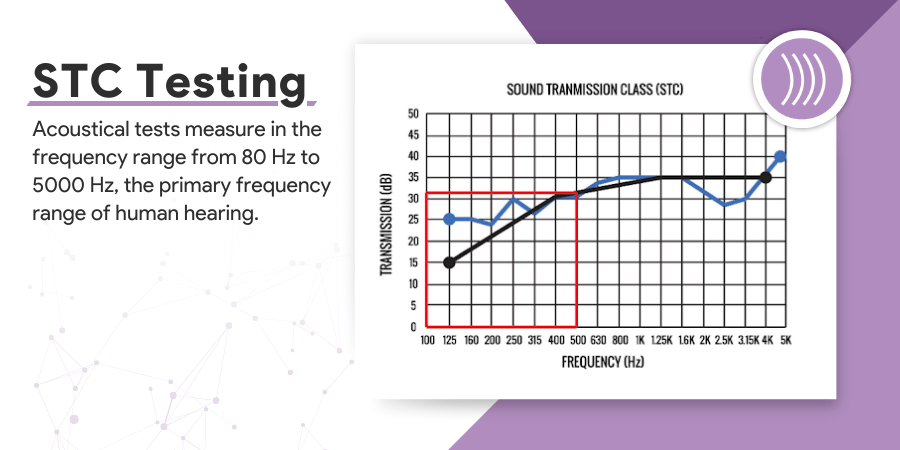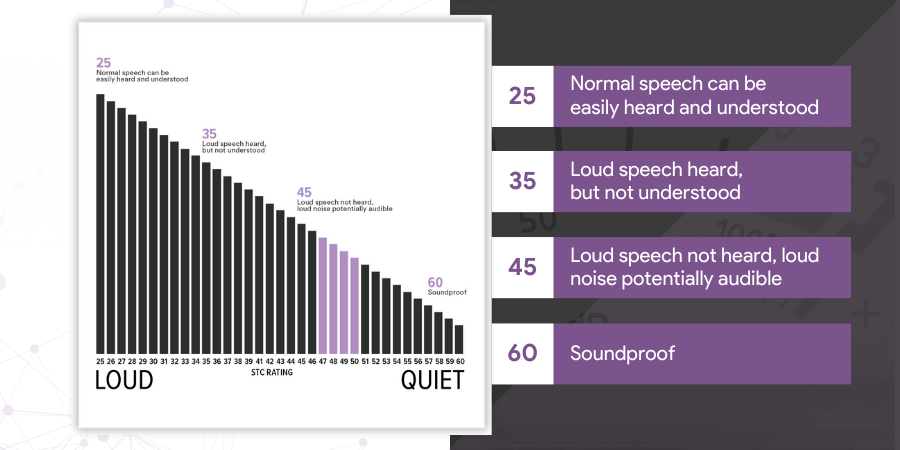Acoustical Testing
Understanding the Basics of Sound Transmission Class (STC) Ratings
No one wants to hear their neighbors arguing or have employees blame low productivity on the talkative person in the office next door. That’s why sound transmission ratings are a critical measure for building products.
By having the sound transmission levels of products and assemblies tested, designers can know long before a space is occupied whether the level of sound reduction will meet end-user expectations.
There are many factors that influence sound transmission class (STC) ratings, and it’s important to understand and plan for these nuances. This article will explain STC ratings, what the testing entails, and how to interpret the ratings.
What Is Sound Transmission Class (STC)?
STC ratings are a standard way to rate the effectiveness of an assembly to attenuate airborne sound. The result is a numerical rating somewhere between 25 and 60+.
While decibels (dB) are a measurement of how loud a noise is, sound transmission class measures the difference in decibels through a product — in other words, how much sound is getting through.
In simpler terms, the STC rating offers an indication of how soundproof a wall or floor/ceiling structure may be.
How Is Sound Transmission Class Rating Determined?
STC ratings are determined with acoustic testing that adheres to the ASTM E90 standard. The test measures the airborne sound attenuating characteristics of partitions, floors, ceilings, windows, doors, or barrier materials.
The transmission loss data is used to establish the STC rating of the unit being tested. Sound insulation is calculated according to the ASTM E413 standard using sound transmission measurements obtained in one-third octave bands as per ASTM E90.
STC Testing Details
Using either partition sound transmission loss chambers or floor-to-ceiling chambers, an acoustical consultant will analyze the attenuation, insulation, or absorption of a material or system at 16 frequencies to assess how well it may perform when installed in the field.
Acoustical tests measure in the frequency range from 80 Hertz to 5000 Hertz, which is the primary frequency range of human hearing. The results are plotted on a sound pressure graph, like the one below, allowing the laboratory to arrive at a single-number rating by fitting the measured data to the ASTM standard rating contour.
Interpreting Ratings With a Sound Transmission Class Chart
Through acoustic testing, you’ve determined an assembly has an STC rating of 50. But what does that really mean?
A sound transmission class chart is a simple way to understand the decibel scale and its relation to STC ratings. A higher sound transmission class rating indicates more effective sound insulation than a lower number.
For reference, the International Building Code (IBC) requires a minimum lab-tested STC rating of 50 per ASTM E90 for walls, floors, and ceilings in new multi-family construction. Using the sound transmission class chart below, a rating of 50 means only very loud sounds can be heard through the assembly.
STC |
Common Sounds Still Heard |
|
25 |
Normal speech can be easily heard and understood |
|
30 |
Loud speech can be easily heard and understood |
|
35 |
Loud speech heard, but not understood |
|
40 |
Loud speech only a murmur |
|
45 |
Loud speech not heard, music system/heavy traffic noise potentially audible |
|
50 |
Very loud sounds can be heard (musical instruments) |
|
60 |
Soundproof |
Factors That Impact STC Ratings
A single-number rating may not always tell the whole story. There are nearly unlimited factors in the field that will impact sound transmission, and many cannot be anticipated in laboratory testing.
For example, buildings in close proximity to an outdoor concert venue or busy road will generate a considerable amount of low-frequency noise that could not be known when the assembly was tested. STC ratings are not appropriate for low-frequency noises, which require a detailed analysis of frequency bands.
Beyond that, material properties, construction techniques, and room acoustics will have an impact. Sound can become structure-borne and travel through assemblies, such as walls connected to ceiling joists and subfloors. Known as flanking paths, this can increase the sound level, but could not be anticipated unless the actual assembly was evaluated.
Testing Gives the Most Complete Picture
Sound transmission class ratings are the most common sound reduction measurement and share the best picture of how much sound isolation is provided. When designing a space that will share walls, floors, or ceilings, STC testing helps meet code and client requirements, as well as avoid overheard arguments and issues in office spaces.
To learn more about acoustic testing, reach out to one of our testing experts today.
Search blog articles
Browse by topic
Subscribe for updates
GET IN TOUCH
Contact Us
NGC Testing Services features one of North America's most comprehensive and unique fully accredited testing facilities. Contact us today to visit our 50,000-plus-square-foot facility located in Buffalo, New York.
